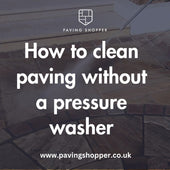
Understanding Paving Slip Ratings: A Comprehensive Guide | EnglishUK
Share
.jpg)
A paving slip rating, also known as a slip resistance or anti-slip rating, is a measure of how slippery a surface is. It is commonly used in the construction and design industry to assess the safety of paving materials, such as tiles, stones, and concrete, in various settings such as walkways, driveways, and pool decks.
Having the correct paving slip rating is crucial for ensuring the safety of pedestrians and minimising the risk of slips, trips, and falls. A study by the Centers for Disease Control and Prevention found that falls are the leading cause of unintentional injuries in the United States, with over 9.2 million emergency room visits each year.
The paving slip rating is measured using a specialised instrument called a pendulum tester, which simulates a person's heel striking a surface and measures the force required to make it slip. The rating is then assigned on a scale from 0 to 100, with higher numbers indicating a lower risk of slipping.
Several factors can affect a paving slip rating, including the type of material, surface texture, and the presence of contaminants like water, oil, or grease. Therefore, it is essential to consider these factors when choosing the right paving material for a specific project.
There are different types of paving slip ratings, with the most common being R Ratings, P Ratings, and A, B, and C ratings. R Ratings are used for pedestrian areas, P Ratings for industrial areas, and A, B, and C ratings for ramps and sloped areas.
Choosing the right paving slip rating for a project depends on the intended use of the area, the expected level of foot traffic, and the potential presence of contaminants. It is essential to follow safety standards and regulations set by organisations such as the American Society for Testing and Materials (ASTM) and the Occupational Safety and Health Administration (OSHA).
To improve the paving slip rating of pavers, various methods can be employed, such as using textured surfaces, anti-slip coatings, and regular cleaning and maintenance. It is crucial to regularly assess and maintain the paving slip rating to ensure the safety of all users.
Key Points:
- Paving slip ratings measure the slip resistance of pavers, helping to prevent accidents and injuries.
- Factors such as surface texture and moisture can greatly affect a paver's slip rating.
- It is important to consider the type of area and level of foot traffic when choosing the appropriate slip rating for a paving project.
What Is a Paving Slip Rating?

Photo Credits: Www.Pavingshopper.Co.Uk by Timothy Martin
"A paving slip rating is a measure of a surface's slip resistance, indicating how likely it is for someone to slip or fall when walking on it. The rating is determined based on various factors such as the texture of the surface, the presence of contaminants or moisture, and the angle of the slope. Commonly used rating systems include the Pendulum Test Value (PTV) and the Ramp Test Value (RTV). These ratings help ensure safety in areas prone to wet or slippery conditions, such as walkways, driveways, and outdoor recreational spaces. Fun fact: Did you know that the PTV rating is measured using a swinging pendulum device?"
Why Is a Paving Slip Rating Important?
Having a paving slip rating is crucial for ensuring safety in outdoor spaces. A slip rating measures the level of slip resistance that a paving material provides, indicating how likely it is for someone to slip and fall on the surface. This information is particularly important in areas with high foot traffic or where water or other liquids may be present. By choosing materials with higher slip ratings, you can reduce the risk of accidents and injuries.
Pro-tip: Always check the slip rating of paving materials before making a decision to prioritize safety.
How Is a Paving Slip Rating Measured?

Photo Credits: Www.Pavingshopper.Co.Uk by Nathan Martin
Paving slip ratings are important for assessing the safety and traction of different paving materials. These ratings measure the slip resistance of a surface and help determine the likelihood of slips and falls. The measurement process involves several steps:
- Preparation: Ensure the test area is clean and free from contaminants.
- Equipment: Use a slip resistance tester, such as a pendulum or tribometer, to measure the surface's slip resistance.
- Testing: Conduct multiple tests in different directions to obtain an average slip resistance value.
- Analysis: Compare the slip resistance value against industry standards to determine the paving slip rating.
By following these steps, experts can accurately measure and assign slip ratings to paving surfaces to ensure safety.
What Factors Affect the Paving Slip Rating?
The slip rating of a paving is affected by various factors that influence its slip resistance. These factors include the texture of the material, the presence of substances such as water or oil, the incline or gradient of the surface, and the type of footwear being used. A rougher texture and a lower presence of contaminants generally result in a higher slip resistance rating. Additionally, surfaces with steeper inclines or gradients may have lower slip resistance. It is important to consider these factors when selecting the appropriate slip rating for a project to ensure optimal safety and minimize the risk of slipping and falling.
In a similar historical context, the ancient Romans recognized the importance of slip-resistant surfaces and used materials such as stone and wood with textured finishes to enhance traction on walkways and roads. They understood that factors such as surface texture and grip are essential for ensuring the safety of pedestrians and travelers. This historical knowledge remains relevant today as we continue to prioritize slip resistance in our modern paving materials.
What Are the Different Types of Paving Slip Ratings?

Photo Credits: Www.Pavingshopper.Co.Uk by Willie Hill
When it comes to choosing the correct material for paving your outdoor area, it is important to consider slip resistance. However, with various types of slip ratings for paving, it can be overwhelming to understand their meanings. In this section, we will explain the different slip ratings for paving, which include R ratings, P ratings, and A, B, and C ratings. By the end, you will have a thorough understanding of the different types of slip ratings for paving and how they can affect your choice of paving material.
1. R Ratings
R ratings are a type of paving slip rating used to measure the slip resistance of a surface. They are important in determining the safety and suitability of a paving material for different areas. Here are the steps to understand R ratings:
- Consult the R rating scale, which ranges from R9 (low slip resistance) to R13 (high slip resistance).
- Consider the specific requirements of your project and the expected level of foot traffic.
- Assess the surface texture, material composition, and maintenance requirements of the paving material.
- Choose a paving material with an appropriate R rating for the area's intended use and safety standards.
Pro-tip: It's always a good idea to consult with industry professionals to ensure you select the right paving slip rating for your project.
2. P Ratings
P ratings are an important aspect of paving slip ratings that measure the slip resistance of surfaces. When considering P ratings for your project, follow these steps:
- Identify the intended use of the paved area and the expected foot traffic.
- Consult building regulations and safety standards to determine the required P rating for your project.
- Consider the environmental conditions that the paving will be exposed to, such as wet or icy conditions.
- Select paving materials with the appropriate P rating to ensure safety and prevent accidents.
- Ensure regular maintenance and cleaning of the paving to maintain its slip resistance over time.
By carefully considering P ratings, you can choose the right paving materials that provide optimal safety and slip resistance for your project.
3. A, B, and C Ratings
Paving slip ratings are classified into three types: A, B, and C. These ratings indicate the level of slip resistance provided by a paving surface. An A rating offers the highest slip resistance, suitable for areas that are prone to wetness or spills. B ratings provide moderate slip resistance, while C ratings indicate a lower level of slip resistance.
When selecting the appropriate paving slip rating, consider the specific requirements of your project and the expected amount of foot traffic. It is important to comply with safety standards to prevent accidents and injuries. If a paving surface has a lower slip rating, it can be improved by using anti-slip coatings or treatments.
How Do I Choose the Right Paving Slip Rating for My Project?

Photo Credits: Www.Pavingshopper.Co.Uk by Eugene Adams
Selecting the right paving slip rating for your project is crucial to ensure safety and prevent accidents. Follow these steps to make the best choice:
- Assess the environment: Consider factors like weather conditions, foot traffic, and the presence of water or oil.
- Understand slip ratings: Familiarise yourself with the different slip ratings, such as R, P, and A, and their corresponding levels of slip resistance.
- Consult professionals: Seek advice from paving experts or architects who have experience in selecting the appropriate slip rating for similar projects.
- Consider the purpose: Determine the intended use of the paved area, whether it's for a residential driveway, commercial walkway, or industrial flooring.
- Test samples: Obtain samples of different paving materials with varying slip ratings and test them in the specific environment to assess their slip resistance.
- Consider maintenance: Evaluate the effort and cost required to maintain the chosen paving material's slip resistance over time.
Remember, safety should always be a top priority. Choose the paving slip rating that best suits your project's needs to minimise the risk of slips and falls.
What Are the Safety Standards for Paving Slip Ratings?

Photo Credits: Www.Pavingshopper.Co.Uk by Dennis Nguyen
When it comes to paving slip ratings, safety standards play a crucial role in ensuring the well-being of pedestrians. These standards specify the acceptable levels of slip resistance for different paving surfaces. The safety standards take into account factors such as surface texture, wetness, and the angle of the slope. They provide guidelines for manufacturers and contractors to follow when designing and installing paving materials. By adhering to these safety standards, the risk of slips and falls can be significantly reduced, creating safer pedestrian environments.
Fact: In the UK, the Health and Safety Executive (HSE) provides guidance on slip resistance standards for different environments, including public areas and workplaces.
How Can I Improve the Paving Slip Rating of My Pavers?

Photo Credits: Www.Pavingshopper.Co.Uk by James Sanchez
To improve the slip resistance of your paving stones, follow these steps:
- Thoroughly clean the surface to remove any dirt, debris, or moss that could cause it to become slippery.
- Apply an anti-slip coating to the stones. This can be in the form of a sealant or a specific anti-slip product.
- Ensure proper drainage to prevent water from accumulating on the surface, as this can increase slipperiness.
- Consider adding texture to the stones by using a broom or brush to create grooves or patterns.
- Regularly maintain the stones by repairing any cracks or damage that could affect their slip resistance.
Frequently Asked Questions
1. What are slip ratings for paving slabs and floor tiles?
Slip ratings for paving slabs and floor tiles are a measure of their resistance to slipping. They are determined through a simple test where a person walks on a lubricated surface with rubber-soled shoes or bare feet. The results are given in an 'R rating' and range from R9 to R13, with higher ratings indicating better slip resistance.
2. How are slip ratings measured for paving slabs and floor tiles?
Slip ratings are measured through various approved methods, including the DIN 51130 Shod Ramp Test, DIN 51097 Barefoot Ramp Test, BS7976 Pendulum, UNE ENV 12633 Pendulum, and the Tortus Dynamic Test. These tests involve walking on a lubricated surface and measuring the slip resistance at various angles.
3. What are the recommended areas for each slip rating?
The recommended areas for each R rating vary. R9 is suitable for dry indoor flooring with minimal water exposure, while R10 is suitable for indoor and outdoor areas with some slip resistance. R11 is suitable for areas with good slip resistance, such as wet rooms and patios. R12 and R13 are recommended for industrial settings and areas with high water exposure.
4. How do slip ratings affect the price of paving slabs and floor tiles?
The slip resistance rating can affect the price of paving slabs and floor tiles. Higher ratings, such as R12 and R13, may be more expensive due to their excellent slip resistance. However, it is important to consider the safety benefits of higher slip ratings in areas with potential slip hazards.
5. What are some suitable areas for each slip rating?
R9 and R10 are suitable for indoor use, while R11, R12, and R13 are recommended for outdoor use or areas with greater water exposure. R11 is considered the standard anti-slip rating for exterior paving tiles in the UK. R12 and R13 are often used in industrial settings such as factory floors and automotive manufacturing plants.
6. How can slip ratings benefit potential buyers?
Understanding slip ratings can help potential buyers make informed decisions when purchasing paving slabs or floor tiles. It can also help them choose the right type of flooring for their specific needs and ensure the safety of their flooring area. Knowing the slip ratings can also help with customer service issues, such as determining the appropriate slip rating for areas like swimming pools or commercial food areas where there may be surface water contamination or dripping coats.
What paving provides good slip resistance?
Textured natural stone paving like Sandstone paving and slate provide good grip and slip resistance underfoot. Porcelain paving can also be formulated with aggregates for non-slip finishes.How can I reduce slips on my patio paving?
To reduce slips on patio paving, choose a textured surface like limestone or Sandstone. Applying an anti-slip coating or sealer also improves traction. And ensure proper drainage to avoid puddles.What are budget tips for non-slip paving?
Affordable non-slip paving options include textured concrete pavers, repurposed bricks, or loose gravel. You can also find great deals on discount paving with adequate grip.How can I upgrade my existing paving's slip resistance?
To upgrade grip, apply an anti-slip coating or treatment to the the paving. Also, regularly clean the surface to prevent moss/algae growth that causes slips. Filling gaps between pavers helps too.What causes wet paving to be slippery?
Wet paving becomes slippery because water acts as a lubricant between the surface and shoes, reducing traction. Smooth finishes also provide less grip. Insufficient drainage and organic growth can worsen slipperiness.Related Posts
-

Why Do Paving Slabs Crack And How To Repair Them
Seeing cracks appear on your patio or driveway can be disheartening after investing time and money into installing be...
-

How to clean paving without a pressure washer
A patio cleaner is a cleaning solution designed specifically for removing dirt, grime, and stains from outdoor patio...
-

Our Custom Feather Flag From Banner World
We've always believed in the power of visuals to convey our message, and recently, we took a significant step in bol...
-

What is the Best Paving for Patios?
When it comes to choosing the best paving for patios, there are a variety of factors to consider, such as durabilit...









